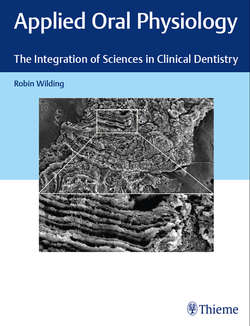Читать книгу Applied Oral Physiology - Robin Wilding - Страница 74
На сайте Литреса книга снята с продажи.
4.3.4 Dental Plaque
ОглавлениеDental plaque is a biofilm which forms on oral surfaces. It is formed by a variety of oral organisms which form an aggregate within an adhesive matrix of salivary and bacterial polymers.
If a tooth surface is thoroughly cleaned, a layer of salivary pellicle forms within hours. Individual bacteria may soon be found attached to the pellicle (▶ Fig. 4.9). The early colonizers are mostly cocci and small rods which stain gram-positive bacteria (See Appendix D.6 Gram Staining Bacteria). Later colonizers are filamentous organisms which form a meshwork and may themselves become the site of attachment for smaller organisms. Adhesion to each other may improve the chances of survival where there is competition for surfaces. When viewed with a scanning electron microscope (SEM), these aggregates of organisms were described by Listgarten as “corn cobs.” A similar arrangement has occurred between some rod-shaped organisms and filament-shaped bacteria which has already attached to the pellicle. These aggregates have been called “bottle brushes.” The attachment of the filamentous organisms to the pellicle is by specific ligands, whereas the interbacterial attachments are by fimbriae. It is not clear what the relationship is between the two species of organisms in these aggregates, but it is likely that there is mutual benefit (▶ Fig. 4.10).
Fig. 4.8 A diagrammatic representation of the stages in development of a biofilm. Note that as the biofilm develops, there is increasingly some organization of microorganisms, which is not present in the planktonic forms or microorganisms.
Fig. 4.9 SEM images of the early colonization of an enamel surface with oral organisms (magnification × 5,000). (a) Coccal and rod-shaped organisms are visible on enamel after 24 hours. (b) Filamentous organisms begin to create an interwoven mesh of organisms after 48 hours.
Fig. 4.10 Plaque organism unable to adhere to an oral surface may attach to organisms which are able to adhere. (a) A SEM image of a corn cob aggregation (magnification × 10,000). (b) A diagrammatic representation of the adhesion between different species of bacteria which gives rise to corn cob (C) and bottle brush (B) aggregates. These adhesive arrangements illustrate cooperation between certain species of cocci and filamentous bacteria.
Successful adhesion to oral surfaces will depend on the preference for different surfaces. Streptococcus salivarius has a preference for the oral mucosa of the cheek, while S. mutans and S. sanguis attach more readily to the tooth surface pellicle. This species preference for sites is due to the presence of receptor sites on the bacteria and on the oral surface, which are complimentary to each other.
After 7 to 10 days, the plaque is mature and is a complex mixture of species containing gram-negative bacteria and spirochetes. The environment within the plaque changes as bacterial products accumulate and as the deeper layers are isolated from the influence of saliva. Channels in the biofilm are created which allow nutrients, oxygen, and bacterial products such as the chemical messengers of quorum sensing to permeate throughout the biofilm (▶ Fig. 4.7).
Several oral organisms produce polysaccharides, which are secreted from the cell and stored outside the organism. There are different types of extracellular polysaccharides, but they have, in common, the ability to help organisms to bind together and also to provide a means of food storage, which the organism can utilize in time of need. Thus, bacteria are able to sustain acid production, up to an hour after a sucrose-containing meal, by metabolizing the glucans they produced while the sucrose was available.
The mature microenvironments of plaque, formed by structural organization and specific competition and cooperation between species, provide a niche for over 200 species (▶ Fig. 4.11) (see Appendix D.7 Microenvironments).
